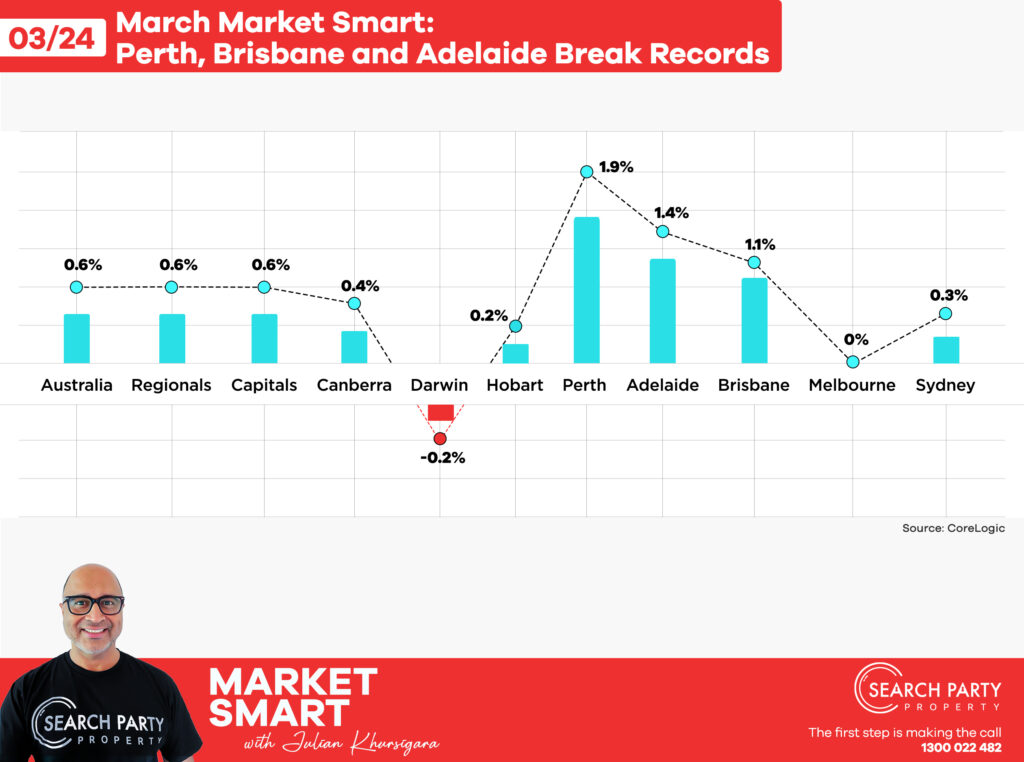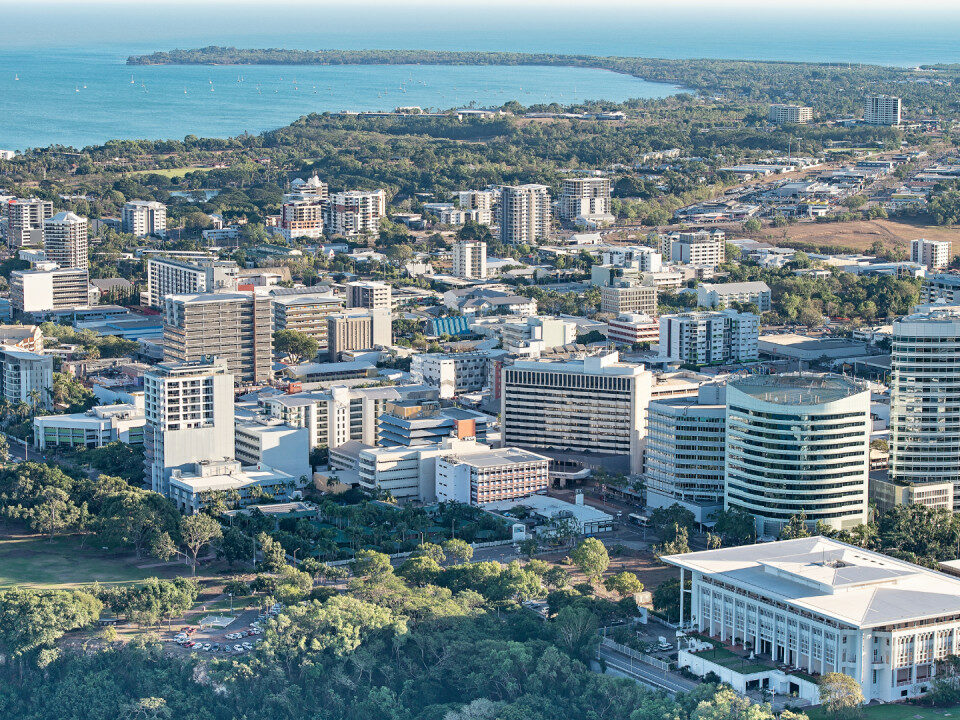- The first step is making the call.
- 1300 022 482
- hello@searchpartyproperty.com.au
31st March 2024 – Property Market Update

March Market Smart – Perth, Brisbane and Adelaide Break Records

Key Takeaways
- Record-breaking price levels across Perth, Brisbane, and Adelaide, with the continued rise in property values over the past month.
- Adelaide leads with a remarkable 1.4% monthly growth, closely followed by Perth at 1.2%, and Brisbane maintaining a steady 1.1% increase.
- The overarching trend indicates a robust market in these cities, defying usual property cycle expectations.
Current Market Trends
In an impressive display of resilience, March has seen Perth, Brisbane, and Adelaide continue to break records in the property market. The buoyancy in these cities is particularly noteworthy against a backdrop of national housing market softening in other areas. This month, Perth has continued its ascendant trajectory with a 1.2% growth, contributing to a 5.6% quarterly rise which is the highest across all state capitals.
Brisbane, not far behind, has witnessed a 1.1% growth over the month, aligning with a broader trend of property value increases in Queensland. Adelaide, however, steals the spotlight with a 1.4% rise in dwelling values, the highest monthly growth recorded, and an impressive 3.3% increase over the quarter.

As we look deeper into these results, the reasons behind such significant growth become clear. Market dynamics indicate a potent combination of low supply and high demand, bolstered by economic factors that foster investment and residential acquisitions. Consumer confidence appears to be mirroring these trends, showing signs of positive sentiment despite the looming concerns of rising interest rates and inflation.
The combined regional markets, although experiencing a softer growth of 0.6% over the past month, still present an aggregate growth that competes closely with the capital cities. This indicates a broadening appeal of regional living, which could be attributed to the lifestyle changes post-COVID and the remote work movement.

Looking at the rolling quarterly performance, the divergence between cities becomes even more pronounced. Perth’s lead in the quarterly figures is clear evidence of its robust market conditions, while Adelaide’s strong performance showcases the city’s emerging potential as a growth hotspot. Brisbane, with its consistent growth, continues to indicate that Queensland remains a focal point for both investors and homebuyers.
As we conclude the first quarter of 2024, the records set by Perth, Brisbane, and Adelaide not only mark a pivotal moment in the current property cycle but also underscore the nuanced nature of regional market performances. These cities, riding the wave of record growth, have firmly established themselves as standout performers in Australia’s complex housing market tapestry.
Sydney and Melbourne, traditionally seen as the powerhouses of the Australian property market, have experienced modest changes. Sydney’s growth remained positive yet tepid at 0.3% over the month, hinting at a market that is stabilizing after intense fluctuations in previous years. Melbourne, on the other hand, saw a slight contraction of -0.2% this quarter, suggesting a cooling phase as the market adjusts to various economic pressures and a re-balancing of demand.
Hobart’s property values stayed nearly flat with a slight increase of 0.1%, indicating a market that may be reaching a plateau after its own period of rapid growth cycles. Darwin faced a minor decline of -0.2%, while Canberra’s market also cooled slightly with a -0.4% change. These variations across the capital cities reflect a diverse and multi-faceted national housing landscape, where regional differences and local factors play a significant role in shaping the market trends.

The national rental index rose by 2.8% in the March quarter, marking the fastest quarterly pace of rental growth since the same period ending May 2022. This surge is a testament to the robust demand for rental properties, particularly as housing affordability challenges continue to steer a portion of the population away from home ownership.
In the capital cities, rental growth varied, with Perth witnessing an impressive annual increase of 13.7% for houses, far outpacing other cities. The unit sector in Perth also saw a significant lift, with rents climbing by 15.9% annually, reflecting the city’s strong demand for more affordable, dense living options. Adelaide and Brisbane trailed with their own substantial year-on-year rises of 9.1% and 7.6% for houses, respectively.
Conversely, markets such as Hobart are showing a downturn, with rents for houses decreasing by -0.8% annually, suggesting a shift in the local rental landscape. This could indicate an increase in housing availability or a shift in tenant preferences. As for the units, Darwin and Canberra demonstrated a notable resilience with increases of 1.6% and 1.2%, respectively, although Hobart experienced a decline of -1.8%.
Things to keep an eye on
- Distressed Property Listings

Domain data indicates that distressed home listings in early 2024 are relatively low across most Australian cities, suggesting stable or improving financial circumstances for homeowners. This trend can have a significant impact on market confidence and housing affordability, possibly leading to reduced urgency among buyers and a more balanced market.
- Housing Affordability

The gap in unit prices per square meter of floor space between Sydney and other cities has narrowed, hinting at an evolving landscape of housing affordability. Potential buyers and investors may find opportunities in markets previously considered less accessible.
- Consumer Sentiment and Economic Indicators

Consumer sentiment indices suggests that consumer confidence is dipping in response to cost-of-living pressures and the outlook for the economy. As inflation and interest rate fears only ease gradually, housing-related sentiment has improved slightly but remains cautious. Notably, nearly 70% of consumers still expect housing prices to rise, despite renewed concerns about economic conditions.
- Investment Property Interest

Search trends for ‘investment property’ correlate with investment housing loan commitments, providing insight into future market activity. An uptick in searches may precede a rise in investment, suggesting an increased interest in the property market.
- Residential Construction Expectations

The Residential Construction Expectations Index has rebounded, reflecting a positive outlook for the housing construction sector. This could indicate an upcoming increase in supply, potentially easing price growth pressures.
At Search Party Property, we specialise in developing tailored investment strategies and will work with you to come up with a suitable plan of attack. We also regularly assess your strategy ensuring that it is fit for purpose and delivering the desired results.




